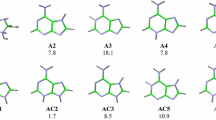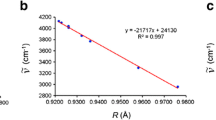Abstract
Interactions between metal ions and amino acids are common both in solution and in the gas phase. The effect of metal ions and water on the structure of l-histidine is examined. The effect of metal ions (Li+, Na+, K+, Mg2+, Ca2+, Ni2+, Cu2+ and Zn2+) and water on structures of His·M(H2O)m, m = 0.1 complexes have been determined theoretically employing density functional theories using extended basis sets. Of the five stable complexes investigated the relative stability of the gas-phase complexes computed with DFT methods (with one exception of K+ systems) suggest metallic complexes of the neutral l-histidine to be the most stable species. The calculations of monohydrated systems show that even one water molecule has a profound effect on the relative stability of individual complexes. Proton dissociation enthalpies and Gibbs energies of l-histidine in the presence of the metal cations Li+, Na+, K+, Mg2+, Ca2+, Ni2+, Cu2+ and Zn2+ were also computed. Its gas-phase acidity considerably increases upon chelation. Of the Lewis acids investigated, the strongest affinity to l-histidine is exhibited by the Cu2+ cation. The computed Gibbs energies ΔG are negative, span a rather broad energy interval (from −130 to −1,300 kJ/mol), and upon hydration are appreciably lowered.


Similar content being viewed by others
References
Alcamí M, González AI, Mó O, Yánez M (1999) Performance of density functional theory methods for the treatment of metal-ligand dications. Chem Phys Lett 307:244–252. doi:10.1016/S0009-2614(99)00513-8
Baerends EJ (2000) Perspective on “self-consistent equations including exchange and correlation effects”. Theor Chem Acc 103:265–269. doi:10.1007/s002140050031
Becke AD (1993a) Density-functional thermochemistry. III. The role of exact exchange. J Chem Phys 98:5648–5652. doi:10.1063/1.464913
Becke AD (1993b) A new mixing of Hartree–Fock and local density-functional theories. J Chem Phys 98:1372–1377. doi:10.1063/1.464304
Besant PG, Attwood PV (2005) Mammalian histidine kinases. Biochim Biophys Acta 1754:281–290. doi:10.1016/j.bbapap.2005.07.026
Bickelhaupt FM, Baerends EJ (2000) Kohn-Sham density functional theory: predicting and understanding chemistry. In: Lipkowitz KB, Boyd DB (eds) Rev Comput Chem, vol 15. Wiley-VCH, New York, pp 1–86
Cerda BA, Wesdemiotis Ch (2000) Zwitterionic vs. charge-solvated structures in the binding of arginine to alkali metal ions in the gas phase. Analyst 125:657–660. doi:10.1039/a909220j
Dunbar RC, Hopkinson AC, Oomens J, Siu ChK, Siu KWM, Steill JD, Verkerk UH, Zhao J (2009) Conformation switching in gas-phase complexes of histidine with alkaline earth ions. J Phys Chem B 113:10403–10408. doi:10.1021/jp903064w
El Khoury Y, Hellwig P (2009) Infrared spectroscopic characterization of copper–polyhistidine from 1, 800 to 50 cm−1: model systems for copper coordination. J Biol Inorg Chem 14:23–34. doi:10.1007/s00775-008-0421-4
Fei WX, Rai AK, Lu ZW, Lin ZJ (2009) Structural stabilities of metalated histidines in gas phase and existence of gaseous zwitterionic histidine conformers. J Mol Struct Theochem 895:65–71. doi:10.1016/j.theochem.2008.10.017
Fitz D, Jakschitz T, Rode BM (2008) The catalytic effect of l- and d-histidine on alanine and lysine peptide formation. J Inorg Biochem 102:2097–2102. doi:10.1016/j.jinorgbio.2008.07.010
Fraústo da Silva JJR, Williams RJP (1991) The biological chemistry of the elements. Claredon Press, Oxford
Frisch MJ et al (2003) Gaussian 03, Revision B.04. Gaussian Inc., Pittsburgh
Gapaev A, Dunbar RC (2003) Na+ affinities of gas-phase amino acids by ligand exchange equilibrium. Int J Mass Spectrom 228:825–839. doi:10.1016/S1387-3806(03)00242-2
Harvey KB, Porter GB (1963) Introduction to physical inorganic chemistry. Addison Wesley Publ. Comp. Inc., London
Hehre WJ, Radom L, Schleyer PvR, Pople JA (1986) Ab initio molecular orbital theory. Wiley, New York
Hoyau S, Norrman K, McMahon TB, Ohanessian GA (1999) Quantitative basis for a scale of Na+ affinities of organic and small biological molecules in the gas phase. J Am Chem Soc 121:8864–8875. doi:10.1021/ja9841198
Huang Z, Yu W, Lin Z (2006) First-principle studies of gaseous aromatic amino acid histidine. J Mol Struct Theochem 801:7–20. doi:10.1016/j.theochem.2006.08.053
Jockusch RA, Price WD, Williams ER (1999) Structure of cationized arginine (Arg·M+, M = H, Li, Na, K, Rb, and Cs) in the gas phase: further evidence for zwitterionic arginine. J Phys Chem A 103:9266–9274. doi:10.1021/jp9931307
Jockusch RA, Lemoff AS, Williams ER (2001) Hydration of valine-cation complexes in the gas phase: on the number of water molecules necessary to form a zwitterion. J Phys Chem A 105:10929–10942. doi:10.1021/jp013327a
Johnson BG, Gill PMW, Pople JA (1993) The performance of a family of density functional methods. J Chem Phys 98:5612–5626. doi:10.1063/1.464906
Jones ChM, Bernier M, Carson E, Colyer KE, Metz R, Pawlow A, Wischow ED, Webb I, Andriole EJ, Poutsma JC (2007) Gas-phase acidities of the 20 protein amino acids. Int J Mass Spectrom 267:54–62. doi:10.1016/j.ijms.2007.02.018
Kapp J, Remko M, PvR Schleyer (1996) HXO and (CH)XO compounds (X = C, Si, Ge, Sn, Pb): Double bonds vs carbene-like structures—can the metal compounds exist at all? J Am Chem Soc 118:5745–5751. doi:0.1021/ja953846p
Kish MM, Ohanessian G, Wesdemiotis C (2003) The Na+ affinities of α-amino acids: side-chain substituent effects. Int J Mass Spectrom 227:509–524. doi:10.1016/S1387-3806(03)00082-4
Kohn W, Sham LJ (1965) Self-consistent equations including exchange and correlation effects. Phys Rev 140:A1133–A1138. doi:10.1103/PhysRev.140.A1133
Kovačević B, Rožman M, Klasinć L, Srzić D, Maksić ZB, Yánez M (2005) Gas-phase structure of protonated histidine and histidine methyl ester: combined experimental mass spectrometry and theoretical ab initio study. J Phys Chem A 109:8329–8335. doi:10.1021/jp053288t
Lavanant H, Hecquet E, Hoppilliard Y (1999) Complexes of l-histidine with Fe2+, Co2+, Ni2+, Cu2+, Zn2+ studied by electrospray ionization mass spectrometry. Int J Mass Spectrom 185/186/187:11–23. doi:10.1016/S1387-3806(98)14044-7
Lee C, Yang W, Parr RG (1988) Development of the Colle–Salvetti correlation-energy formula into a functional of the electron density. Phys Rev B 37:785–789. doi:10.1103/PhysRevB.37.785
Li F, Fitz D, Fraser DG, Rode BM (2009) Catalytic effects of histidine enantiomers and glycine on the formation of dileucine and dimethionine in the salt-induced peptide formation reaction. Amino Acids. doi:10.1007/s00726-009-0249-4
Madden JJ, McGandy EL, Seeman NC (1972) The crystal structure of the orthorhombic form of L-(+)-histidine. Acta Cryst B28:2377–2382. doi:10.1107/S0907444907043417
Marino T, Russo N, Toscano M (2000) Gas-phase metal ion (Li+, Na+, Cu+) affinities of glycine and alanine. J Inorg Biochem 79:179–185. doi:10.1016/S0162-0134(99)00242-1
Norberg J, Foloppe N, Lennart N (2005) Intrinsic relative stabilities of the neutral tautomers of arginine side-chain models. J Chem Theory Comput 1:986. doi:10.1021/ct049849m
O’Hair RJ, Bowie JH, Gronert S (1992) Gas phase acidities of the α amino acids. Int J Mass Spectrom Ion Process 117:23–36. doi:10.1016/0168-1176(92)80083-D
Oakley F, Horn NM, Thomas AL (2004) Histidine-stimulated divalent metal uptake in human erythrocytes and in the erythroleukaemic cell line HEL.92.1.7. J Physiol 561:525–534. doi:10.1007/BF00675792
Oliphant N, Bartlett RJ (1994) A systematic comparison of molecular properties obtained using Hartree–Fock, a hybrid Hartree–Fock density-functional-theory, and coupled-cluster methods. J Chem Phys 100:6550–6561. doi:10.1063/1.467064
Plankensteiner K, Reiner H, Rode BM (2005) Stereoselective differentiation in the salt-induced peptide formation reaction and its relevance for the origin of life. Peptides 26:535–541. doi:10.1016/j.peptides.2004.11.019
Poater J, Sola M, Rimola A, Rodriguez-Santiago L, Sodupe M (2004) Ground and low-lying states of Cu2+-H2O. A difficult case for density functional. J Phys Chem A 108:6072. doi:10.1021/jp0487657
Rai AK, Fei WX, Lu ZW, Lin ZJ (2009) Effects of microsolvation and aqueous solvation on the tautomers of histidine: a computational study on energy, structure and IR spectrum. Theor Chem Acc 124:37–47. doi:10.1007/s00214-009-0577-1
Rebek J (1990) On the structure of histidine and its role in enzyme active sites. Struct Chem 1:129–131. doi:10.1007/BF00675792
Remko M (1997) Structure and gas phase stability of complexes L…M, where M = Li+, Na+, Mg2+ and L is formaldehyde, formic acid, formate anion, formamide and their sila derivatives. Mol Phys 91:929–936. doi:10.1080/002689797171049
Remko M, Rode BM (2000a) Bivalent cation binding effect on formation of the peptide bond. Chem Phys Lett 316:489–494. doi:10.1016/S0009-2614(99)01322-6
Remko M, Rode BM (2000b) Thermodynamics of binding of Li+, Na+, Mg2+ and Zn2+ to Lewis bases in the gas phase. J Mol Struct Theochem 505:269–281. doi:10.1016/S0166-1280(99)00381-4
Remko M, Rode BM (2001) Catalyzed peptide bond formation in the gas phase. Phys Chem Chem Phys 3:4667–4673. doi:10.1039/b105623a
Remko M, Rode BM (2004) Catalyzed peptide bond formation in the gas phase. Role of bivalent cations and water in formation of 2-aminoacetamide from ammonia and glycine and in dimerization of glycine. Struct Chem 15:223–232. doi:10.1023/B:STUC.0000021531.69736.00
Remko M, Rode BM (2006) Effect of metal ions (Li+, Na+, K+, Mg2+, Ca2+, Ni2+, Cu2+, and Zn2+) and water coordination on the structure of glycine and zwitterionic glycine. J Phys Chem A 110:1960–1967. doi:0.1021/jp054119b
Remko M, von der Lieth C-W (2006) Gas-phase and solution conformations of selected dimeric structural units of heparin. J Chem Inf Model 46:1687–1694. doi:10.1021/ci060060+
Remko M, Fitz D, Rode BM (2008) Effect of metal ions (Li+, Na+, K+, Mg2+, Ca2+, Ni2+, Cu2+, and Zn2+) and water coordination on the structure and properties of l-arginine and zwitterionic l-arginine. J Phys Chem A 112:7652–7661. doi:10.1021/jp801418h
Rimola A, Rodríguez-Santiago L, Sodupe M (2006) Cation-π interactions and oxidative effects on Cu+ and Cu2+ binding to Phe, Tyr, Trp, and His amino acids in the gas phase. Insights from first-principles calculation. J Phys Chem B 110:24189–24199. doi:10.1021/jp064957l
Rimola A, Rodriguez-Santiago L, Ugliengo P, Sodupe M (2007) Is the peptide bond formation activated by Cu2+ Interactions? Insights from density functional calculations. J Phys Chem B 111:5740–5747. doi:10.1021/jp071071o
Rode BM (1999) Peptides and the origin of life. Peptides 20:773–786. doi:10.1016/S0196-9781(99)00062-5
Rode BM, Bujdák J, Eder AH (1993) The role of inorganic substances in the chemical evolution of peptides on earth. Trends Inorg Chem 3:45–62
Ryzhov V, Dunbar RC, Cerda B, Wesdemiotis Ch (2000) Cation-π effects in the complexation of Na+ and K+ with Phe, Tyr, and Trp in the gas phase. J Am Soc Mass Spectrom 11:1037. doi:10.1016/S1044-0305(00)00181-1
Sakurai T, Iwasaki H, Katano T, Nakahashi Y (1978) Bis(L-histidinato)nickel(II) monohydrate. Acta Cryst B34:660–662. doi:10.1107/S0567740878003738
Shriver DF, Atkins PW, Langford CH (1996) Inorganic chemistry, 2nd edn. Oxford University Press, Oxford
Siegel H, Martin RB (1982) Coordinating properties of the amide bond. Stability and structure of metal ion complexes of peptides and related ligands. Chem Rev 82:385–426. doi:10.1021/cr00050a003
Sousa SF, Fernandes PA, Ramos MJ (2007a) Comparative assessment of theoretical methods for the determination of geometrical properties in biological zinc complexes. J Phys Chem B 111:9146–9152. doi:10.1021/jp072538y
Sousa SF, Fernandes PA, Ramos MJ (2007b) General performance of density functionals. J Phys Chem A 111:10439. doi:10.1021/jp0734474
Tavasoli E, Fattahi A (2009a) DFT study of bond energies and attachment sites of sample divalent cations (Mg2+, Ca2+, Zn2+) to histidine in the gas phase. J Theor Comput Chem 8:347–371
Tavasoli E, Fattahi A (2009b) DFT study on gas-phase interaction between histidine and alkali metal ions (Li+, Na+, K+); and influence of these ions on histidine acidity. J Theor Comput Chem 8:475–490
Voet D, Voet JG (1995) Biochemistry, 2nd edn. Wiley, New York
Wang P, Ohanessian G, Wesdemiotis Ch (2008) The sodium ion affinities of sparagines, glutamine, histidine and arginine. Int J Mass Spectrom 269:34–45. doi:10.1016/j.ijms.2007.09.008
Wincel H (2007a) Hydration of potassiated amino acids in the gas phase. J Am Soc Mass Spectrom 18:2083–2089. doi:10.1016/j.jasms.2007.09.006
Wincel H (2007b) Hydration energies of sodiated amino acids from gas-phase equilibria determinations. J Phys Chem A 111:5784–5791. doi:10.1021/jp0721595
Zhang MQ, Leurs R, Timmerman H (1997) Histamine H1-receptor antagonists. In: Wolff ME (ed) Burger’s medicinal chemistry and drug discovery, 5 edn, vol 5: Therapeutic agents. Wiley, New York
Acknowledgments
The authors thank the Austrian Federal Ministry for Science and Research, the Austrian Science Foundation (FWF), and the Slovak Ministry of Education (Grant No. 1/0084/10) for financial support.
Author information
Authors and Affiliations
Corresponding author
Rights and permissions
About this article
Cite this article
Remko, M., Fitz, D. & Rode, B.M. Effect of metal ions (Li+, Na+, K+, Mg2+, Ca2+, Ni2+, Cu2+ and Zn2+) and water coordination on the structure and properties of l-histidine and zwitterionic l-histidine. Amino Acids 39, 1309–1319 (2010). https://doi.org/10.1007/s00726-010-0573-8
Received:
Accepted:
Published:
Issue Date:
DOI: https://doi.org/10.1007/s00726-010-0573-8




